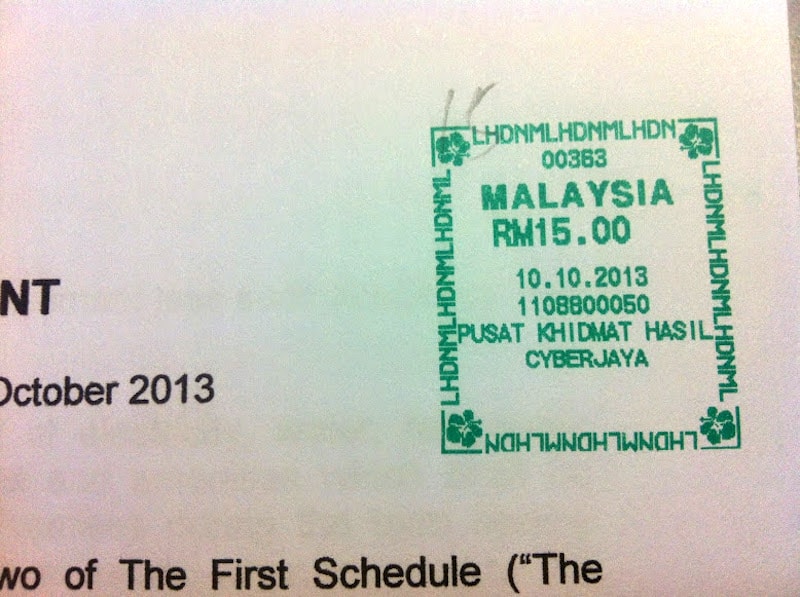


This article is intended as a simple guide to tenancy agreements, and is written for landlords who wish to rent out their property in Malaysia. It covers tenancy agreements in Malaysia; what they are, why you need it as a landlord, the tenancy process, deposit amounts, and simple tenancy agreement sample as reference.
Table of Contents
Even though the profit from rental property has dropped over the years (a landed house will fetch 2.5% rental yield today vs 5% a decade ago), it’s a tried and tested way to generate income while owning an appreciating asset.
However, while many people think that rental income is equivalent to passive income, this is not always true. There are many expenses and much effort needed when it comes to managing a rental property. These include listing costs, property agent fees, as well as upkeep of the property (during and in between tenancies).
There are hidden costs, too, especially if you run into problems with your tenant. If you don’t have a tenancy contract drawn up between you and the tenant, it will be harder resolve any disputes. A prolonged dispute can quickly cancel out any profits that you have gained from the rental income.
That’s why, to protect both the landlord and the tenant’s welfare, a clearly-worded tenancy agreement is important.

A tenancy agreement is a legal contract between the landlord and the tenant. It covers the responsibilities of both sides for the duration of the tenancy.
To make the tenant agreement as complete as possible, a landlord can hire a lawyer to draft it out. And the tenant can engage their own lawyer to review the agreement and make any changes before signing.
But, hiring a lawyer to draft a tenancy agreement can be expensive. So, many people choose to draft their own agreement and ask the other party to agree to it.
A word of caution about tenancy contracts in Malaysia: there are no government regulations about what can and cannot be added. If either party is not careful, one side can add lots of unfair clauses in their own favour.
Until the Residential Rent Act (see side note) comes into effect, the tenancy agreement is the only document that protects the rights of the landlord and the tenants .
Side note: Residential Rent ActTo protect the interests of both landlords and tenants in a fair way, the recent Malaysia Budget 2018 proposed a “ Residential Rent Act ” to establish a more robust rental law in Malaysia.
The Act would help outline the basic rights of landlords and tenants, and could include
At the moment, there is no such Act in place, so the most important thing is to have a clear tenancy agreement.
A tenancy agreement is the only document that protects the rights of the landlord and the tenants
Property expert Mark Chua prefers to think of tenancies as business arrangements. As he puts it, “[He] is not my tenant. I am not his landlord. We are equal business partners aiming for a win-win relationship”
At its basic level, a tenancy agreement should cover these items:
There are many details to cover. And the details have to be worded so that there is minimal room for misunderstanding.
The landlord and tenant will sign the tenancy agreement when the security deposit is paid.
Here is the typical sequence:

There are three deposits in total:
Earnest deposit : The first deposit is the earnest deposit. It is basically a booking deposit, or a deposit to “reserve” the property so that the landlord will not rent the property to anyone else for the next 7 days. The amount is equivalent to the first month’s rent. It can be kept in escrow by the property agent. When the tenancy starts, the earnest deposit is usually considered the first month’s rent. Or, it can be used as the security deposit, or it can even be returned to the tenant.
The earnest deposit is also accompanied by a signed “letter of offer” from the tenant. This is a simple one-page document that signifies the tenant’s intent to rent the property.
Security deposit : The security deposit is collected to protect the landlord in case the tenants violate the terms of the tenancy. The amount is usually equivalent to two month’s rent. It can be used to pay for damages, cleaning, keycard replacements, or even be forfeited entirely if the tenant leaves before the tenancy has ended. But if there are no problems by the end of the tenancy, the full amount is returned to the tenant.
Utility deposit : The utility deposit is paid to cover any outstanding utility bills at the end of the tenancy, such as gas, electricity and water. The amount is usually equivalent to half a month’s rent.
The security deposit and utility deposit is paid at the same time as the signing of the tenancy agreement.
Example calculation for rental deposit if the monthly rental is RM1,000:
When you and your tenant have come to an agreement on the tenancy agreement, both parties need to sign it.
However, it is not a valid legal document (ie. admissible in court) until it is stamped by Lembaga Hasil Dalam Negeri Malaysia (LHDN) or Malaysia Inland Revenue Authority.
You can bring the agreement to your nearest LHDN office to get it stamped. There will be a charge for this, known as the stamp duty.
During your visit to the LHDN office, you will also be asked to submit two application forms, namely PDS 1 and PDS 49(A). You can view these forms at the LHDN website .
According to local rental listings site Speedrent , the stamp duty for tenancy agreements in Malaysia is calculated as follows:
Example stamp duty calculation for a 1-year tenancy where the monthly rental is RM1,500:
Annual rental = RM1,500 * 12 months = RM18,000
Rental in excess of RM2,400 = RM18,000 – 2,400 = RM15,600
Stamp duty = 15,600 / 250 * RM1 = RM62.40
It is advisable to get original copies stamped for each party. That means one for the landlord, one for the tenant, and one for the agent (if applicable).

Tenancy agreements, like any other legal document, are carefully worded by lawyers to make sure that there is minimal room for misinterpretation.
Unfortunately, that also makes it full of legal jargon that can be difficult to understand.
Below we provide a simple breakdown of the common clauses found in a tenancy agreement.
We have also provided a sample tenancy agreement containing all the clauses mentioned below. You can download it and amend it as needed. Download sample tenancy agreement
The cover page includes the date of the agreement, and the names and IC number of the parties involved.
Example cover page:
DATED : 1 JANUARY 2018
THE LANDLORD : ARTHUR LIM AH TER (IC NO: 111111-11-1111)
AND THE TENANT : AHMAD BIN ISMAIL (IC NO: 111111-22-2222)
FOR THE DEMISED PREMISE :
A1-01-01 HAPPY CONDOMINIUM
JALAN SULTAN IDRIS SHAH
The next part of the document establishes some definitions, including the “landlord”, “tenant”, and “demised premises”. To make the paperwork easier, the first part of the agreement does not contain any actual details of the property, contact details, rental amounts, etc. It simply refers to a separate section known as the “Schedule” and the “Inventory”. All the actual information is entered in the Schedule.
THIS TENANCY AGREEMENT is made the day and year stated in Section 1 of the Schedule hereto
Between the party whose name and description are stated in Section 2 of the Schedule hereto (hereinafter called the “Landlord”) of the one part
And the party whose name and description are stated in Section 3 of the Schedule hereto (hereinafter called the “Tenant”) of the other part.
WHEREAS the Landlord is the legal and beneficial owner of the demised unit described in Section 4 of the Schedule hereto (hereinafter referred to as the “Demised Premises”).
The next three clauses specify the tenancy start and end date, rental amounts as well as the security deposit and utility deposit. Again, all the actual deposit amounts are included in the “Schedule” section later on.
The next section covers the responsibilities and obligations of the tenant. We have added yellow highlighted text to explain what each clause means in simpler terms.